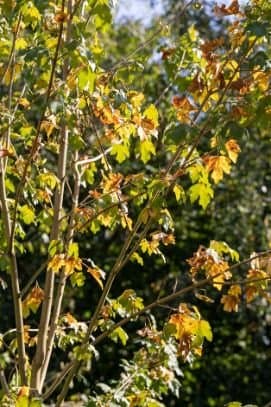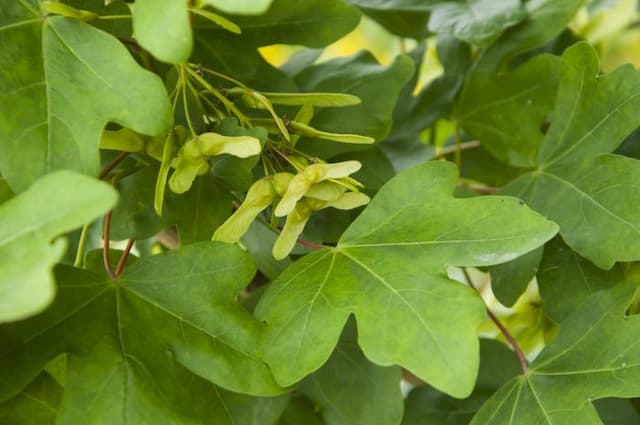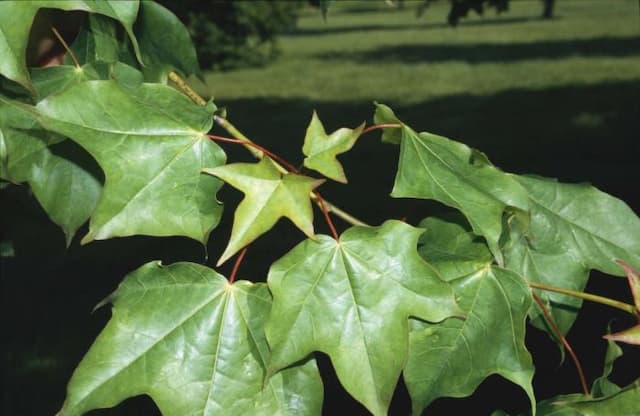Japanese Maple Acer palmatum 'Kinran' (M)

ABOUT
The Japanese maple 'Kinran' is a stunning cultivar known for its ornate foliage and striking seasonal changes. Its leaves are deeply cut and palm-like, which is characteristic of the Japanese maple family. The foliage boasts a rich mix of colors. During the spring, new leaves emerge in a vibrant shade of golden-yellow, with veins that are highlighted in a contrasting shade of red, giving the foliage an embossed appearance. As the seasons progress, the leaves transform, taking on a deeper hue. The red veins become more pronounced against the golden tones of the leaf, creating a tapestry of warm colors that seem to glow when backlit by sunlight. In autumn, the Japanese maple 'Kinran' undergoes another dramatic change as the leaves turn to fiery shades of crimson and gold, making it a standout specimen for fall color. The overall form of the 'Kinran' Japanese maple is one of elegance and grace. Its branching structure provides an open, layered appearance that can add depth and texture to garden spaces. As it matures, the branches spread out to create a canopy that displays the intricate beauty of its leaves, which flutter delicately with the slightest breeze. This cultivar of Japanese maple is a true showcase plant that brings a vivid play of colors to any landscape in which it is planted.
About this plant
 Names
NamesFamily
Sapindaceae
Synonyms
Japanese Maple, Kinran Japanese Maple
Common names
Acer palmatum 'Kinran'
 Toxicity
ToxicityTo humans
The Japanese maple is generally not considered toxic to humans. There are no well-documented cases of poisoning from ingesting parts of this plant, and it is commonly grown without special precautions regarding human safety. However, like with any plant, individual allergic reactions or sensitivity to plant components can occur, so consuming any part of the Japanese maple is not advisable.
To pets
The Japanese maple is not known to be toxic to pets such as dogs and cats. It is not listed as a poisonous plant for animals by major pet health organizations. However, ingestion of non-food items, including plants, can cause gastrointestinal upset in pets, leading to symptoms like vomiting or diarrhea. If a pet ingests a large quantity of the plant and exhibits signs of distress, it is best to consult a veterinarian.
 Characteristics
CharacteristicsLife cycle
Perennials
Foliage type
Deciduous
Color of leaves
Varies
Height
6-8 feet (1.8-2.4 meters)
Spread
6-8 feet (1.8-2.4 meters)
Plant type
Tree
Hardiness zones
5-8
Native area
Japan
Benefits
 General Benefits
General Benefits- Aesthetic Appeal: Japanese Maple 'Kinran' enhances gardens with its vibrant foliage and attractive shape.
- Seasonal Interest: Offers a spectacle of changing colors through the seasons, from bright green in spring to golden and crimson hues in autumn.
- Shade Tolerance: Can thrive in partially shaded areas where other plants may struggle.
- Low Maintenance: Requires minimal pruning and can grow well without extensive care.
- Compact Size: Its relatively small stature makes it suitable for smaller gardens or container planting.
- Wildlife Habitat: Provides shelter and sustenance for various species of birds and insects.
 Medical Properties
Medical PropertiesThis plant is not used for medical purposes.
 Air-purifying Qualities
Air-purifying QualitiesThis plant is not specifically known for air purifying qualities.
 Other Uses
Other Uses- Acer palmatum 'Kinran', commonly known as Japanese maple, can be utilized in bonsai art due to its intricate branch patterns and vibrant foliage.
- The leaves of Japanese maple can be pressed and preserved in books or frames as a form of botanical art, capturing their stunning colors and shapes.
- Its wood, often with unique grain patterns due to its growth habits, is sometimes used in the crafting of fine furniture or decorative woodwork.
- Japanese maples can serve as a natural privacy screen when planted in groups, offering a more aesthetic solution than fences or artificial barriers.
- The sap of Japanese maple can be used in small quantities for syrup production, similar to that of sugar maples, although it is not common practice.
- Leaves of the Japanese maple can be used in compost as they decompose to add nutrients back into the soil, promoting a healthy garden ecosystem.
- In cultural ceremonies, particularly in Japan, the leaves of Japanese maple might be used as natural decorations or symbolic elements in various festivals or art forms.
- The tree can be incorporated into landscape photography workshops to teach techniques like capturing reflections, seasonal changes, or color contrasts.
- Japanese maple can be strategically planted to create microclimates within a garden, influencing the growth and health of surrounding plant life.
- The tree has been inspiration for textile designs, capturing its leaf shapes and colors in fabrics used for clothing, curtains, or other decorative items.
Interesting Facts
 Feng Shui
Feng ShuiThe Japanese Maple is not used in Feng Shui practice.
 Zodiac Sign Compitability
Zodiac Sign CompitabilityThe Japanese Maple is not used in astrology practice.
 Plant Symbolism
Plant Symbolism- Beauty: Acer palmatum 'Kinran', also known as Japanese Maple, is highly regarded for its aesthetic appeal due to its ornate leaves and captivating colors, symbolizing beauty in nature.
- Change: The Japanese Maple's leaves change color with the seasons, representing the ever-changing nature of life and the grace to adapt with it.
- Peace: The serene and calming presence of the Japanese Maple in gardens conveys a sense of peace and tranquility, encouraging quiet reflection.
- Balance: With its harmonious structure, the tree illustrates balance, suggesting stability in growth and proportion.
- Endurance: Despite its delicate appearance, the Japanese Maple is relatively hardy, representing endurance and the ability to withstand challenges.
 Water
WaterJapanese Maple trees, including the 'Kinran' variety, prefer evenly moist soil that is well-draining. They should be watered deeply once a week, offering about 10 gallons of water per inch of trunk diameter at chest height during the growing season. Adjustments need to be made for rainfall, with less water provided when there's ample rain and potentially more during hot, dry periods. Watering should be reduced in the fall and late into the dormant season to match the tree's reduced needs. When watering, avoid wetting the foliage directly to reduce the risk of fungal diseases, focusing instead on the soil around the base of the tree.
 Light
LightThe Japanese Maple 'Kinran' thrives in partial shade to full sun conditions. It does best when protected from the harsh afternoon sun, especially in hotter climates, to prevent leaf scorch. A spot that provides morning sunlight and dappled afternoon shade is ideal for promoting vibrant foliage without causing stress to the tree.
 Temperature
TemperatureJapanese Maples like 'Kinran' prefer a temperate climate and are hardy in a range of temperatures. They can generally tolerate a minimum winter temperature of around -10 to -20 degrees Fahrenheit and a maximum summer temperature of about 80 to 90 degrees Fahrenheit. For optimal growth, a spring to fall temperature range of 50 to 70 degrees Fahrenheit is ideal.
 Pruning
PruningPruning the Japanese Maple 'Kinran' is done to maintain shape, remove dead wood, and promote healthy growth. Light pruning can be performed any time of year, but major pruning is best done in late winter before new growth starts. Thinning out the canopy helps to increase air circulation and light penetration. Aim to prune no more than one-third of the tree in a single season, focusing on cutting back to healthy, outward-facing buds.
 Cleaning
CleaningAs needed
 Soil
SoilThe Japanese Maple 'Kinran' thrives in well-draining, consistently moist soil enriched with organic matter. A mix with equal parts of loam, peat, and sharp sand is optimal, ensuring good aeration and water retention. The ideal pH for this mix should be slightly acidic, ranging from 5.5 to 6.5.
 Repotting
RepottingJapanese Maples like 'Kinran' should be repotted every two to three years to refresh the soil and allow for root growth. Juvenile trees may require more frequent repotting, while mature specimens can be repotted less often.
 Humidity & Misting
Humidity & MistingJapanese Maple 'Kinran' prefers moderate to high humidity levels, with ideal conditions ranging from 40% to 70%. They can tolerate lower humidity levels but perform best when the surrounding air isn't too dry.
 Suitable locations
Suitable locationsIndoor
Ensure bright, indirect light and protection from drafts for indoor Japanese Maple 'Kinran'.
Outdoor
Plant in dappled shade, protect from harsh winds for outdoor Japanese Maple 'Kinran'.
Hardiness zone
5-8 USDA
 Life cycle
Life cycleThe Japanese Maple 'Kinran' starts its life cycle as a seed, which after stratification germinates in the spring. Upon germination, the seedling emerges, developing its first set of true leaves uniquely patterned with red or purple hues in this cultivar. As a young sapling, it undergoes rapid growth and eventually matures into an adult tree with a beautifully shaped canopy, marked by palmate leaves that turn striking colors in the fall. During its reproductive phase, the mature Japanese Maple produces small, inconspicuous flowers in spring, followed by the development of winged samaras, or seed pods, which disperse with the wind. After many years, the tree may reach the senescence phase where growth slows, and it may become more susceptible to environmental stresses and diseases. Throughout its life, this deciduous tree undergoes an annual cycle of leafing out in the spring, vigorous summer growth, dazzling fall foliage, and winter dormancy.
 Propogation
PropogationPropogation time
Late winter-early spring
The Japanese Maple 'Kinran', known for its striking foliage, is commonly propagated through grafting, a method which allows for the replication of the exact characteristics of a particular cultivar. This technique often employs a rootstock of a more vigorous or disease-resistant Japanese Maple species onto which the 'Kinran' scion wood is grafted. Timing for grafting Japanese Maples typically occurs in late winter or early spring when the plants are still dormant, typically before the sap begins to flow. The process involves taking a small branch or bud from the 'Kinran' and joining it to the rootstock, ensuring the cambium layers – the actively growing tissue between the wood and the bark – are in contact. The graft is then tightly wrapped to maintain this contact and seal out air and pathogens, and kept under appropriate conditions to encourage the tissue to fuse and grow as one plant.







![Freeman maple [Autumn Blaze]](/_next/image?url=https%3A%2F%2Fplants-admin.emdemapps.com%2Fimages%2Fplants%2F%2Fimages%2F604b575b84d87.png&w=640&q=75)

